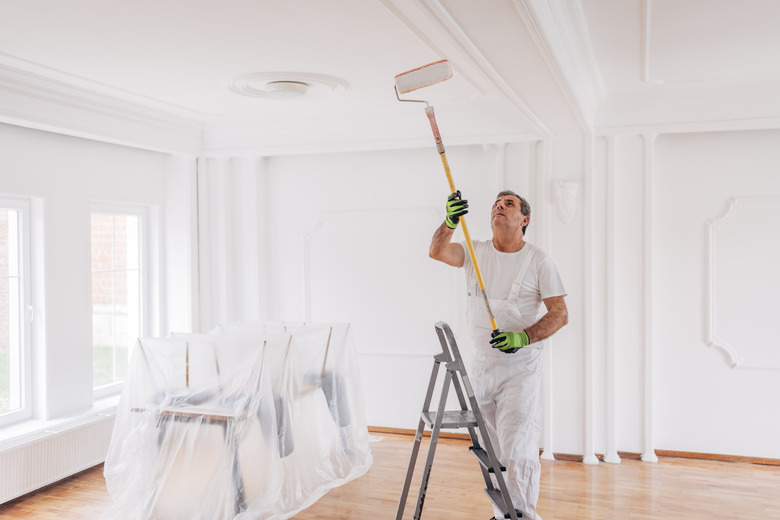What Kind Of Paint Covers Nicotine-Stained Ceilings?
We may receive a commission on purchases made from links.
Tobacco smoke indoors reaches just about every surface in a room, including the ceiling. The nicotine within that smoke leaves unsightly yellow or brownish stains all over, and simply applying a fresh coat of paint on the ceiling isn't enough to solve the problem. If possible, wash the ceiling first to help remove some of the residue. A stain-blocking primer is the real key to ensuring the discoloration doesn't come through the new paint, followed by a quality latex ceiling or interior paint.
Tip
The primer is even more important than the paint when it comes to blocking nicotine stains on the ceiling. Choose a stain-blocking interior primer and apply two coats if needed or as recommended on the label. Afterward, follow up with a quality water-based ceiling paint or a thick latex interior paint.
Cleaning the Ceiling
Cleaning the Ceiling
Paint doesn't cover or adhere as well on dirty, dusty surfaces, which means you'll have to clean the ceiling before priming and painting. Remove dust by either vacuuming it with a brush attachment or by using a microfiber dust mop with a handle long enough to reach the ceiling. For a textured ceiling, a vacuum cleaner is the better option.
If your ceiling has minimal or no texture, wash it with 1 part white vinegar and 5 parts water in a bucket large enough for a sponge mop. Place a plastic drop cloth over all furniture and the floor to catch drips and then dip the sponge mop into the solution, wringing out most of the moisture. Wipe the entire ceiling surface and then let it air-dry before priming. To work around ceiling fixtures, climb a ladder and use a sponge instead of the mop. Wear eye protection to ensure nothing gets in your eyes as you work overhead.
Priming the Ceiling
Priming the Ceiling
Regular primer is a lot like thinned paint and doesn't really cover much; it just gives the paint something to which it can cling. On the other hand, a stain-blocking primer covers the nicotine residue on the ceiling to ensure that both the discoloration and the odor don't seep through to the new paint. Stain-blocking primers come in water-based, oil, or shellac formats, with the water-based format emitting the least odor.
With advancements in paint technology, even some of the water-based stain-blocking primers do a good job of covering nicotine stains. For instance, the Kilz Restoration Interior Primer label says this water-based primer performs as well as oil- and shellac-based products, and it's designed for restoration and disaster recovery.
Even with a water-based primer, opening the windows helps air out the home as you work and while the primer dries. Tape off the perimeter of the ceiling to avoid getting the primer on the walls and then apply the primer with a roller designed for the amount of texture on your ceiling. Allow the primer to dry as directed on the label before applying a second coat if it needs one. If you see a yellow discoloration coming through, wait for the primer to dry a little longer and then apply another coat.
Painting the Ceiling
Painting the Ceiling
Though the primer does the bulk of the work when it comes to blocking stains and odors, it's still a good idea to choose a quality paint, as bargain paints don't always cover as well and require more coats, which adds to the cost. Ceiling paint is thicker than the average interior paint, which makes it less prone to dripping as you paint overhead, but it's otherwise virtually the same thing. In most cases, thicker paint also means you can get away with one coat if you're using ceiling paint.
Choose a latex or water-based ceiling paint or a thick/high-viscosity latex interior paint for the ceiling for optimal coverage. The paint manufacturer's website lists the full specifications, including the viscosity information for any particular paint formulation, which helps you compare the thickness of two different brands. The higher the Krebs unit, or KU number, the thicker the paint.
